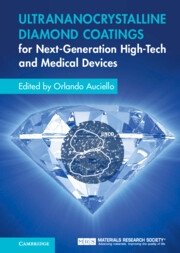Book contents
- Ultrananocrystalline Diamond Coatings for Next-Generation High-Tech and Medical Devices
- Ultrananocrystalline Diamond Coatings for Next-Generation High-Tech and Medical Devices
- Copyright page
- Contents
- Contributors
- Preface
- 1 Fundamentals on Synthesis and Properties of Ultrananocrystalline Diamond (UNCD™) Coatings
- 2 Ultrananocrystalline Diamond (UNCD™) Film as a Hermetic Biocompatible/Bioinert Coating for Encapsulation of an Eye-Implantable Microchip to Restore Partial Vision to Blind People
- 3 Science and Technology of Ultrananocrystalline Diamond (UNCD™) Coatings for Glaucoma Treatment Devices
- 4 Science and Technology of Novel Integrated Biocompatible Superparamagnetic Oxide Nanoparticles Injectable in the Human Eye and External Ultrananocrystalline Diamond (UNCD™)-Coated Magnet for a New Retina Reattachment Procedure
- 5 Science and Technology of Biocompatible Ultrananocrystalline Diamond (UNCD™) Coatings for a New Generation of Implantable Prostheses
- 6 Science and Technology of Novel Ultrananocrystalline Diamond (UNCD™) Scaffolds for Stem Cell Growth and Differentiation for Developmental Biology and Biological Treatment of Human Medical Conditions
- 7 New Generation of Li-Ion Batteries with Superior Specific Capacity Lifetime and Safety Performance Based on Novel Ultrananocrystalline Diamond (UNCD™)-Coated Components for a New Generation of Defibrillators/Pacemakers and Other Battery-Powered Medical and High-Tech Devices
- 8 Science and Technology of Integrated Nitride Piezoelectric/Ultrananocrystalline Diamond (UNCD™) Films for a New Generation of Biomedical MEMS Energy Generation, Drug Delivery, and Sensor Devices
- 9 Science and Technology of Integrated Multifunctional Piezoelectric Oxides/Ultrananocrystalline Diamond (UNCD™) Films for a New Generation of Biomedical MEMS Energy Generation, Drug Delivery, and Sensor Devices
- 10 Biomaterials and Multifunctional Biocompatible Ultrananocrystalline Diamond (UNCD™) Technologies Transfer Pathway
- Index
- References
4 - Science and Technology of Novel Integrated Biocompatible Superparamagnetic Oxide Nanoparticles Injectable in the Human Eye and External Ultrananocrystalline Diamond (UNCD™)-Coated Magnet for a New Retina Reattachment Procedure
Published online by Cambridge University Press: 08 July 2022
- Ultrananocrystalline Diamond Coatings for Next-Generation High-Tech and Medical Devices
- Ultrananocrystalline Diamond Coatings for Next-Generation High-Tech and Medical Devices
- Copyright page
- Contents
- Contributors
- Preface
- 1 Fundamentals on Synthesis and Properties of Ultrananocrystalline Diamond (UNCD™) Coatings
- 2 Ultrananocrystalline Diamond (UNCD™) Film as a Hermetic Biocompatible/Bioinert Coating for Encapsulation of an Eye-Implantable Microchip to Restore Partial Vision to Blind People
- 3 Science and Technology of Ultrananocrystalline Diamond (UNCD™) Coatings for Glaucoma Treatment Devices
- 4 Science and Technology of Novel Integrated Biocompatible Superparamagnetic Oxide Nanoparticles Injectable in the Human Eye and External Ultrananocrystalline Diamond (UNCD™)-Coated Magnet for a New Retina Reattachment Procedure
- 5 Science and Technology of Biocompatible Ultrananocrystalline Diamond (UNCD™) Coatings for a New Generation of Implantable Prostheses
- 6 Science and Technology of Novel Ultrananocrystalline Diamond (UNCD™) Scaffolds for Stem Cell Growth and Differentiation for Developmental Biology and Biological Treatment of Human Medical Conditions
- 7 New Generation of Li-Ion Batteries with Superior Specific Capacity Lifetime and Safety Performance Based on Novel Ultrananocrystalline Diamond (UNCD™)-Coated Components for a New Generation of Defibrillators/Pacemakers and Other Battery-Powered Medical and High-Tech Devices
- 8 Science and Technology of Integrated Nitride Piezoelectric/Ultrananocrystalline Diamond (UNCD™) Films for a New Generation of Biomedical MEMS Energy Generation, Drug Delivery, and Sensor Devices
- 9 Science and Technology of Integrated Multifunctional Piezoelectric Oxides/Ultrananocrystalline Diamond (UNCD™) Films for a New Generation of Biomedical MEMS Energy Generation, Drug Delivery, and Sensor Devices
- 10 Biomaterials and Multifunctional Biocompatible Ultrananocrystalline Diamond (UNCD™) Technologies Transfer Pathway
- Index
- References
Summary
Retinal detachment is the separation of the sensory retinal tissue from the underlying pigmented epithelium, resulting in partial or total loss of human vision. Worldwide, 1:10,000 people per year suffer retina’s detachment. Current treatments include: 1) repositioning the sensory retina onto the rest of the retinal tissue, sealing the gap via laser heating or external freezing treatment. Current therapies for retina’s reattachment include using a silicone ring or a gas bubble to push the retina back into place. These modalities suffer from drawbacks such as choroidal detachment when using the silicone ring, or postoperative positioning of the patient. These techniques are not optimal for treating retinal detachment in the lower part of the eye. Thus, this chapter describes R&D that demonstrated a revolutionary method for retina reattachment, using a solution containing iron oxide super-paramagnetic nanoparticles (FDA approved) injected in the vitreous space of a rabbit eye and a rare earth magnet implanted on the sclera region outside the eye. Superparamagnetic particles, magnetic only when exposed to a magnetic field, are attracted to the magnet area pushing the retina back into place, then dissolve when the magnet is extracted.The magnet is coated with a biocompatible Ultrananocrystalline Diamond (UNCD) coating.
Keywords
- Type
- Chapter
- Information
- Ultrananocrystalline Diamond Coatings for Next-Generation High-Tech and Medical Devices , pp. 121 - 140Publisher: Cambridge University PressPrint publication year: 2022



